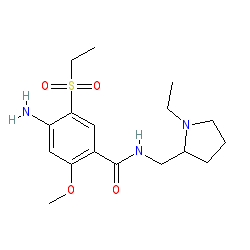GtoPdb is requesting financial support from commercial users. Please see our sustainability page for more information.
|
Synonyms: (±)-amisulpride | Barhemsys®
amisulpride is an approved drug
Compound class:
Synthetic organic
Comment: The approved drug amisulpride is a racemic mixture of (+)-amisulpride and (-)-amisulpride. The structure shown here does not specify stereochemistry and represents the mixture. The links to external resources in the table above all match the INN-assigned compound amisulpride without stereochemistry specified. Alternative stereoisomers are represented by CID 5746246 and CID 3055076.
The INN-assigned compound sultopride has a similar but distinct structure to amisulpride; however the nomenclature for these two compounds is sometimes used interchangeably on other resources. Ligand Activity Visualisation ChartsThese are box plot that provide a unique visualisation, summarising all the activity data for a ligand taken from ChEMBL and GtoPdb across multiple targets and species. Click on a plot to see the median, interquartile range, low and high data points. A value of zero indicates that no data are available. A separate chart is created for each target, and where possible the algorithm tries to merge ChEMBL and GtoPdb targets by matching them on name and UniProt accession, for each available species. However, please note that inconsistency in naming of targets may lead to data for the same target being reported across multiple charts. ✖
View more information in the IUPHAR Pharmacology Education Project: amisulpride |
|
|||||||||||||||||||||||||||||||||||
| No information available. |
Summary of Clinical Use  |
| This drug is an atypical antipsychotic used to treat psychosis in schizophrenia and manic episodes of bipolar disorder. However, there is no information regarding approval for use of this drug for these indications on the US FDA or European Medicines Agency websites. Other national approval agencies may have granted marketing authorisation for use in these conditions. In February 2020 the FDA granted approval for amisulpride injection (Barhemsys) to be used to help prevent postoperative nausea and vomiting. Amisulpride causes dose- and concentration-dependent QT prolongation, so caution is advised for patients with pre-existing medical conditions or who are taking other medications, that are known to prolong the QT interval. Avoid use of amisulpride in patients with congenital long QT syndrome or who are taking droperidol. |
Mechanism Of Action and Pharmacodynamic Effects  |
| Amisulpride is primarily an antagonist of the dopamine D2 and D3 receptors. |







